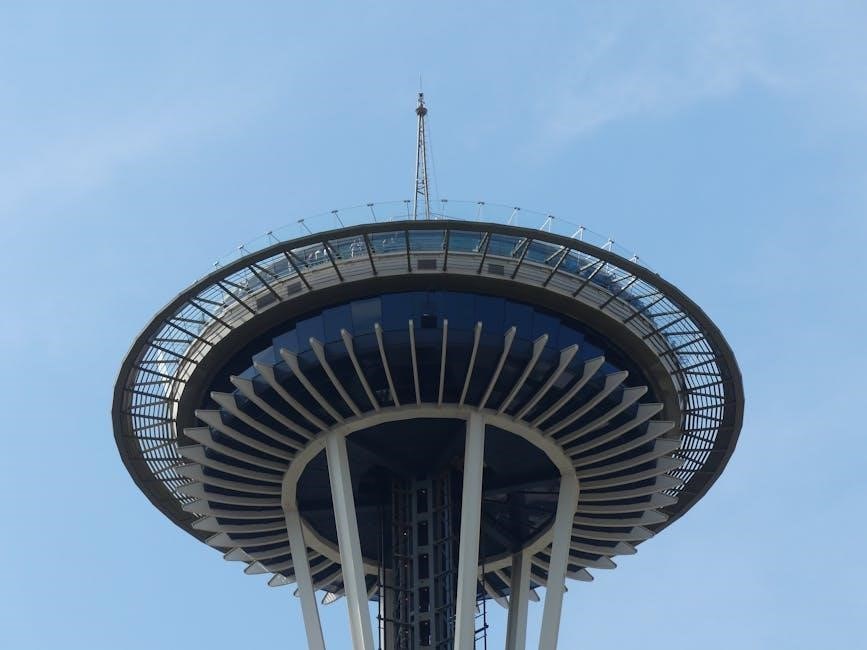The Seattle Stormwater Manual provides comprehensive guidance for managing stormwater effectively, ensuring water quality protection, and promoting sustainable practices in compliance with local and national regulations.
Overview of the Manual’s Purpose and Scope
The Seattle Stormwater Manual provides detailed guidance for managing stormwater runoff to protect water quality, reduce pollution, and promote sustainable development. It applies to all projects within Seattle, ensuring compliance with local and national regulations. The manual covers design criteria, best management practices (BMPs), and maintenance requirements for stormwater systems. It serves as a resource for designers, builders, and regulators, offering a structured approach to stormwater management. The manual includes five volumes and appendices, addressing topics like hydraulic design, green infrastructure, and enforcement mechanisms. Its scope ensures alignment with environmental goals and legal standards, fostering a sustainable urban environment.
Historical Context and Evolution of the Manual
The Seattle Stormwater Manual was first introduced in 2009 to address growing stormwater management challenges. It has undergone significant updates, with the 2016 revision incorporating new BMP design guidelines and compliance standards. The 2021 update expanded the manual into five volumes, covering regulatory requirements, design criteria, implementation, monitoring, and resources. These updates reflect evolving environmental regulations and advancements in stormwater management practices. The manual continues to adapt, with proposed 2026 updates aiming to address emerging challenges and integrate innovative technologies for sustainable stormwater solutions. This evolution ensures the manual remains a critical tool for Seattle’s environmental stewardship.
Key Objectives and Benefits of the Manual
The manual’s primary objectives include protecting water quality, reducing pollution, and promoting sustainable stormwater management. It benefits the city by providing clear design and regulatory standards, ensuring compliance with local and national permits. The manual also fosters environmental stewardship through green infrastructure and BMPs, safeguarding public health and natural habitats. By offering a structured approach, it aids developers, engineers, and planners in implementing effective stormwater strategies. These benefits collectively enhance Seattle’s urban resilience and contribute to the preservation of its ecosystems for future generations. The manual is a vital resource for achieving these goals effectively and sustainably.

Regulatory Framework and Compliance
The Seattle Stormwater Manual ensures compliance with local and national regulations, including SMC chapters, NPDES requirements, and state permits, to protect water quality and public infrastructure.
Seattle Municipal Code (SMC) Chapters 22.800-22.808
SMC Chapters 22.800-22.808 outline the regulatory framework for stormwater management in Seattle, establishing standards to protect public health, safety, and welfare. These chapters detail requirements for stormwater systems, ensuring compliance with local and environmental regulations. They cover design, construction, and maintenance of stormwater infrastructure, promoting sustainable practices and water quality protection. The code is regularly updated to reflect evolving environmental needs and compliance requirements, ensuring Seattle remains a leader in stormwater management.
National Pollutant Discharge Elimination System (NPDES) Requirements
The NPDES requirements mandate compliance with federal regulations to reduce pollutant discharges into waterways. Seattle’s Stormwater Manual aligns with the 2019-2024 Phase I NPDES permit, ensuring stormwater systems meet strict water quality standards. These requirements focus on controlling discharges from municipal separate storm sewer systems (MS4s) and preventing harmful pollutants from entering lakes, rivers, and Puget Sound. Compliance involves implementing best management practices (BMPs), monitoring, and reporting to protect aquatic ecosystems and public health. The manual incorporates these federal standards to maintain environmental integrity and promote sustainable stormwater management practices citywide.
State Waste Discharge General Permit Compliance
The Seattle Stormwater Manual ensures compliance with the State Waste Discharge General Permit for municipal stormwater systems. This permit regulates discharges from medium and large MS4s, requiring the implementation of BMPs to minimize pollution. The manual aligns with state standards, focusing on controlling runoff, reducing contaminants, and protecting water quality. It includes design guidelines, monitoring requirements, and maintenance protocols to meet permit conditions. Compliance ensures that stormwater systems effectively manage runoff, safeguarding Seattle’s waterways and ecosystems. The manual’s framework supports adherence to both state and federal environmental regulations, promoting sustainable stormwater management practices throughout the city.

Stormwater Management Principles
The Seattle Stormwater Manual outlines principles emphasizing sustainable practices, water quality protection, and pollution prevention through BMPs and green infrastructure to manage urban runoff effectively.
Best Management Practices (BMPs) for Stormwater
Best Management Practices (BMPs) are strategies and devices designed to manage stormwater runoff effectively, reducing pollution and enhancing water quality. These practices include green infrastructure, such as rain gardens, green roofs, and permeable pavements, which mimic natural hydrologic processes. BMPs also involve structural controls like stormwater ponds and swales, as well as non-structural measures like erosion control and public education. The Seattle Stormwater Manual emphasizes BMPs to mitigate urban runoff impacts, protect aquatic habitats, and ensure compliance with regulatory requirements. Proper implementation of BMPs is crucial for maintaining healthy waterways and promoting sustainable urban development.
Sustainable Design and Green Infrastructure
Sustainable design and green infrastructure are central to the Seattle Stormwater Manual, emphasizing eco-friendly solutions to manage urban runoff. Green infrastructure includes systems like green roofs, rain gardens, and permeable pavements, which absorb and filter rainwater, reducing stormwater volume and improving water quality. These designs mimic natural processes, enhancing urban resilience and biodiversity. By integrating green infrastructure into urban planning, Seattle aims to create sustainable, livable communities while meeting regulatory requirements and protecting local waterways from pollution. This approach aligns with broader environmental goals, promoting a balanced and sustainable urban environment.
Water Quality Protection and Pollution Prevention
The Seattle Stormwater Manual emphasizes water quality protection through effective pollution prevention strategies. It outlines measures to reduce contaminants in stormwater runoff, such as sediment, nutrients, and bacteria, which can harm aquatic ecosystems. Green infrastructure and best management practices (BMPs) are promoted to filter and treat runoff naturally. The manual also highlights the importance of public education and outreach to prevent illicit discharges and improper waste disposal. By addressing pollution at its source, the manual supports compliance with water quality standards and protects Seattle’s lakes, rivers, and Puget Sound from environmental degradation.

Volume 1: Regulatory Requirements
Protecting water quality is a cornerstone of the manual, focusing on reducing stormwater pollutants through sustainable practices. Strategies include filtering runoff, managing sediments, and preventing harmful discharges into waterways, ensuring compliance with environmental standards and preserving Seattle’s ecosystems.
Compliance Standards for Stormwater Systems
Compliance standards for stormwater systems in Seattle are outlined to ensure effective management and environmental protection. These standards align with local, state, and federal regulations, including the Seattle Municipal Code and NPDES permits. Key components include design criteria, permitting requirements, and inspection protocols. Systems must meet specific thresholds for water quality and flow control. Enforcement mechanisms are in place to address non-compliance, ensuring accountability and adherence to established guidelines. Regular audits and reporting are required to maintain compliance, fostering a culture of environmental stewardship and sustainable stormwater management practices across the city.
Permitting Process and Procedures
The permitting process for stormwater systems in Seattle involves submitting detailed applications and plans to regulatory authorities. Applicants must comply with the Seattle Municipal Code and NPDES requirements. Permits are issued after thorough review, ensuring designs meet environmental and safety standards. Key steps include pre-application consultations, document submission, and approval by relevant agencies. Inspections are conducted to verify compliance during and after construction. Failure to adhere to permitting procedures may result in enforcement actions. The process ensures that stormwater management systems align with legal and environmental goals, protecting water quality and public infrastructure.
Inspection and Enforcement Mechanisms
The Seattle Stormwater Manual outlines rigorous inspection and enforcement mechanisms to ensure compliance with stormwater regulations. Regular inspections are conducted by authorized personnel to verify adherence to design and operational standards. Non-compliance may result in enforcement actions, including corrective orders, fines, or legal proceedings. Inspections focus on BMPs, flow control structures, and maintenance practices. Documentation of inspection findings is required, and repeat violations may escalate enforcement measures. Public reporting and transparency are emphasized to promote accountability; These mechanisms aim to protect water quality, public health, and infrastructure while ensuring sustainable stormwater management practices are upheld across the city.

Volume 2: Design Criteria and Standards
Volume 2 provides detailed design criteria and standards for stormwater management, ensuring projects meet hydraulic, hydrologic, and BMP design requirements while aligning with Seattle’s environmental goals and regulations.
Hydraulic and Hydrologic Design Criteria
The hydraulic and hydrologic design criteria in the Seattle Stormwater Manual provide detailed methodologies for designing stormwater systems. These criteria ensure that stormwater facilities, such as ponds, swales, and flow control structures, are appropriately sized and configured to manage runoff effectively. The manual includes hydrologic calculations, hydraulic design principles, and performance standards to protect water quality and prevent flooding. It also references tools like the Hydrologic and Hydraulic Design Spreadsheet and provides guidance on integrating green infrastructure into designs. These criteria align with Seattle’s environmental goals and regulatory requirements, ensuring sustainable and resilient stormwater management practices. Updates in the 2021 manual enhance design precision and compliance with evolving standards.
Stormwater BMP Design Guidelines
The Seattle Stormwater Manual provides detailed design guidelines for Best Management Practices (BMPs) to effectively manage stormwater runoff. These guidelines address water quality protection, flow control, and habitat restoration. BMPs include bioretention facilities, permeable pavements, and green roofs, each with specific design criteria. The manual emphasizes site-specific considerations, such as soil conditions and drainage areas. It also outlines construction and maintenance requirements to ensure long-term functionality. Case studies and updated design criteria from the 2021 manual offer practical examples and improved standards for implementing BMPs, promoting sustainable stormwater management and compliance with regulatory standards. These guidelines support Seattle’s environmental goals and water quality objectives.
Site Planning and Layout Considerations
The Seattle Stormwater Manual emphasizes the importance of integrating stormwater management into site planning and layout. It recommends preserving natural drainage patterns, minimizing impervious surfaces, and utilizing green infrastructure. Designers are encouraged to consider topography, soil types, and existing vegetation when locating stormwater BMPs. The manual also highlights the need to balance stormwater management with site accessibility and functionality; Proper site planning ensures that stormwater systems are efficient, cost-effective, and environmentally sustainable, aligning with Seattle’s goals for water quality protection and urban resilience. These considerations help developers meet regulatory requirements while maintaining aesthetic and functional site design. This approach supports long-term environmental and community benefits.

Volume 3: Implementation and Construction
Volume 3 focuses on practical aspects of stormwater system construction, detailing control measures to prevent pollution, erosion, and sedimentation, ensuring compliance and long-term sustainability.
Construction Stormwater Control Measures
Construction stormwater control measures are essential to prevent pollution and erosion during development. These measures include temporary erosion controls, sedimentation ponds, and runoff management systems; The manual outlines specific requirements for implementing these controls, ensuring compliance with local and national regulations. Proper installation and maintenance of these measures are critical to protecting water quality and preventing environmental harm; The guidelines also emphasize the importance of regular inspections and adaptive management strategies to address site-specific challenges effectively. By adhering to these standards, construction projects can minimize their environmental impact while meeting regulatory obligations.
Erosion and Sediment Control Techniques
Erosion and sediment control techniques are vital for minimizing soil displacement during construction. The manual specifies methods such as silt fencing, geotextiles, and revegetation to stabilize soil and prevent sediment runoff. These techniques must be tailored to site conditions to ensure effectiveness. Regular maintenance and inspections are required to address potential issues promptly. By implementing these controls, construction sites can reduce their environmental footprint and comply with regulatory standards, ultimately protecting water quality and ecosystems from sedimentation. Effective erosion management ensures sustainable development and preservation of natural resources for future generations.
Post-Construction Maintenance Requirements
Post-construction maintenance is crucial for ensuring stormwater systems function as designed. Regular inspections, cleaning, and repairs are required to maintain efficiency and prevent clogging. Property owners must document maintenance activities and submit reports to comply with regulations. Proper upkeep ensures long-term effectiveness, protecting water quality and reducing pollution. The manual outlines specific schedules and procedures for maintenance, emphasizing the importance of sustainability and environmental stewardship. By adhering to these requirements, stakeholders can ensure the continued performance of stormwater management systems, supporting Seattle’s commitment to ecological health and resilience.

Volume 4: Monitoring and Enforcement
Volume 4 outlines monitoring requirements to ensure compliance with stormwater regulations, enforcement actions for non-compliance, and adaptive management strategies to improve stormwater management practices continuously.
Stormwater Monitoring Requirements
The Seattle Stormwater Manual outlines specific monitoring requirements to ensure compliance with regulations and effectiveness of stormwater management systems. These include regular inspections, water quality sampling, and continuous monitoring of BMPs. Data collected is analyzed to assess system performance and identify areas for improvement. Monitoring frequency and methods vary based on the type and size of the stormwater system. Annual reporting is required to document findings and ensure transparency. These requirements help maintain water quality, prevent pollution, and protect aquatic ecosystems. Compliance with monitoring protocols is enforced through inspections and regulatory oversight. Proper documentation is essential for accountability and system optimization;
Enforcement Actions for Non-Compliance
The Seattle Stormwater Manual outlines enforcement measures for non-compliance with stormwater regulations. These include notices of violation, corrective action requirements, and potential penalties. Inspections are conducted to ensure adherence to stormwater management plans. Failure to address violations may result in fines or legal action. The City prioritizes voluntary compliance but escalates enforcement for repeat or severe offenses. Enforcement actions aim to protect water quality and public health while ensuring accountability for stormwater management practices. Compliance is mandatory, and non-compliance can lead to significant consequences, emphasizing the importance of proper stormwater system maintenance and reporting.
Adaptive Management and Continuous Improvement
The Seattle Stormwater Manual emphasizes adaptive management and continuous improvement to address evolving stormwater challenges. Regular monitoring and assessment of stormwater systems ensure effectiveness and identify areas for enhancement. Public feedback and emerging technologies are integral to refining practices. The manual encourages iterative updates, incorporating lessons learned and innovative solutions. This proactive approach ensures Seattle’s stormwater management remains effective and sustainable, adapting to changing environmental conditions and regulatory requirements while fostering a culture of ongoing improvement and community engagement in stormwater stewardship.

Volume 5: Resources and Appendices
Volume 5 provides essential resources, including technical guidelines, case studies, and funding options, to support stormwater project implementation and compliance with the Seattle Stormwater Manual requirements.
Technical Guidelines and References
The Seattle Stormwater Manual includes detailed technical guidelines to ensure effective stormwater management. These guidelines cover best practices for design, installation, and maintenance of stormwater systems, including green infrastructure. References to local and national standards, such as the NPDES requirements, are provided to guide compliance. The manual also offers case studies and examples of successful projects, demonstrating practical applications of its principles. Additional resources, like design standards and safety protocols, support engineers and planners in creating sustainable solutions. This section is a comprehensive toolkit for professionals working on stormwater projects in Seattle.
Case Studies and Examples
The Seattle Stormwater Manual includes real-world case studies and examples to illustrate effective stormwater management practices; These examples highlight successful projects that integrate green infrastructure, such as rain gardens and green roofs, to reduce runoff and improve water quality. The manual features detailed descriptions of implemented designs, including their challenges, solutions, and outcomes. These case studies serve as valuable resources for engineers, planners, and developers, offering practical insights into sustainable stormwater management. They demonstrate how innovative approaches can meet regulatory requirements while benefiting the environment and communities in Seattle.
Funding and Incentives for Stormwater Projects
The Seattle Stormwater Manual highlights various funding sources and incentives to support stormwater management initiatives. These include grants, tax incentives, and rebates for implementing green infrastructure, such as rain gardens and permeable pavements. Public-private partnerships and federal programs also provide financial support for sustainable stormwater projects. Additionally, the manual outlines cost-sharing opportunities and low-interest loans for property owners and developers. These incentives aim to encourage compliance with stormwater regulations while promoting environmentally friendly practices that enhance water quality and community resilience in Seattle.

Appendices and Supporting Documents
The appendices provide additional resources, including technical guidelines, case studies, and detailed design standards, to support effective stormwater management practices in Seattle.
Maintenance Requirements for BMPs
The Seattle Stormwater Manual outlines detailed maintenance requirements for Best Management Practices (BMPs) to ensure their long-term effectiveness. Regular inspections, cleaning, and vegetation management are essential. Property owners must maintain records of all upkeep activities. Specific guidelines for BMPs, such as bioretention facilities and permeable pavements, are provided to prevent clogging and ensure proper water infiltration. Failure to comply with these requirements may result in enforcement actions. The manual also emphasizes the importance of adaptive management to address evolving stormwater challenges and protect Seattle’s water quality.
Flow Control Structures Design
Flow control structures are critical for managing stormwater runoff in Seattle. The manual provides design criteria to ensure these structures effectively regulate flow rates, prevent flooding, and protect water quality. Engineers must consider hydrologic and hydraulic analyses to properly size and place these structures. Compliance with local regulations and integration with green infrastructure are emphasized. Regular maintenance is required to ensure functionality. Proper design and installation of flow control structures are essential for meeting Seattle’s stormwater management objectives and safeguarding urban and natural environments from excessive runoff impacts.
Additional Design and Safety Standards
The Seattle Stormwater Manual outlines additional design and safety standards to ensure stormwater systems are durable, functional, and safe. These standards address material specifications, structural integrity, and hazard mitigation. Designers must consider factors like accessibility, erosion prevention, and emergency access. Safety features such as fencing, signage, and fall protection are mandated for certain structures. The manual also provides guidelines for integrating stormwater systems with urban landscapes while minimizing risks to public health and safety. Compliance with these standards ensures that stormwater management systems are both effective and safe for the community. Regular updates reflect evolving best practices and technologies.

Updates and Revisions to the Manual
The 2021 Seattle Stormwater Code and Manual became effective on July 1, 2021, with proposed updates for 2026. Revisions incorporate regulatory changes, new technologies, and public feedback.
2021 Seattle Stormwater Code and Manual Updates
The 2021 Seattle Stormwater Code and Manual became effective on July 1, 2021. It introduced updated design criteria, compliance standards, and Best Management Practices (BMPs) for stormwater systems. The revisions included enhanced requirements for green infrastructure, improved water quality protections, and expanded maintenance obligations. These updates reflect advances in stormwater management and align with federal and state environmental regulations. The 2021 manual also incorporated feedback from stakeholders, ensuring it addresses emerging challenges and supports sustainable urban development. The updates aim to protect Seattle’s waterways and public health while promoting efficient stormwater solutions.
Proposed 2026 Updates and Changes
The proposed 2026 updates to the Seattle Stormwater Manual aim to enhance stormwater management practices, incorporating advancements in green infrastructure and emerging technologies. These changes will include stricter design criteria for stormwater systems, expanded requirements for water quality protection, and updated maintenance standards. The revisions also address climate change impacts and emphasize adaptive management strategies. Public feedback will be integral to the finalization process, ensuring the updates reflect stakeholder needs. The 2026 updates are scheduled to take effect in July 2026, aligning with federal and state environmental permit requirements to safeguard Seattle’s waterways and public health effectively.
Process for Public Comment and Feedback
The Seattle Stormwater Manual encourages public engagement through a structured comment and feedback process. The City provides draft updates on its official website, allowing stakeholders to review and submit input. Public meetings and workshops are held to discuss proposed changes, ensuring transparency and inclusivity. Feedback is collected through online portals and reviewed by technical teams to inform final revisions. This collaborative approach ensures the manual reflects diverse perspectives, fostering a balanced and effective stormwater management framework that addresses community needs and environmental goals. Timelines for submission are clearly outlined to facilitate participation.
The Seattle Stormwater Manual is a crucial guide for effective stormwater management, ensuring compliance with regulations and protecting the environment through sustainable practices and continuous improvement.
Importance of the Manual for Seattle’s Stormwater Management
The Seattle Stormwater Manual is crucial for protecting water quality, promoting sustainable practices, and ensuring regulatory compliance. It provides essential guidelines for managing stormwater effectively, safeguarding public health, and preserving Seattle’s natural environment. By outlining best management practices and design standards, the manual helps prevent pollution and supports green infrastructure. Its importance lies in addressing Seattle’s unique urban challenges, such as protecting Puget Sound and managing rainfall efficiently. The manual also fosters economic benefits by reducing stormwater-related risks to property and infrastructure, making it a cornerstone of Seattle’s environmental and urban planning strategies.
Future Directions and Challenges
The Seattle Stormwater Manual aims to adapt to emerging challenges, such as climate change and urban growth, while advancing green infrastructure and equity in stormwater management. Future updates, like the proposed 2026 revisions, will focus on innovative technologies and stricter water quality standards. However, challenges remain, including funding constraints, public awareness, and balancing development with environmental protection. Addressing these issues will require collaboration between stakeholders to ensure the manual remains a robust tool for sustainable stormwater management in Seattle.
